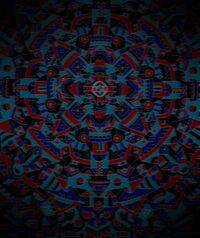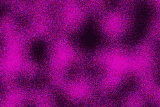Dissociative geometry
Geometry can be described as the experience of a person’s field of vision being partially or completely encompassed by fast-moving, kaleidoscopic, and indescribably complex geometric patterns, form constants, shapes, fractals, structures, and color.
Geometry never stands still at any point, and is often extremely fast-changing and self-transforming in terms of its shape and style. During this process, the geometry naturally drifts laterally or radially across the visual field to create overlapping webs of many arising and decaying geometric patterns, all of which are visible within a single perceptual frame.
In comparison to psychedelic geometry, the dissociative equivalent is significantly less complex, but primarily immersive in its style. It takes a person's view point directly into the centre of the geometry being displayed, as if the geometry is surrounding the person with 3-dimensional depth with a sense of physical size and distance attributed to them. Psychedelic geometry, however, is primarily non-immersive and therefore displays itself on a veil in front of one's visual field with no sense of particular size attributed to them.
In terms of their stylistic appearance, dissociative geometry also tends to be darker colored and slower in terms of their movement and the way in which they shift in their shape across themselves. These usually only display themselves when the tripper has their eyes closed or are in darkness.
Dissociative geometry can only be broken down into 4 possible levels, as opposed to the 8 differing levels of intensity found within psychedelic geometry. These levels can be broken down and described as:
- Visual Noise – This is the most basic level of geometry and can be experienced in a completely sober state. It can be described as visual noise or static combined with random light and dark red regions that can be seen under the eyelids.
- Motion and Colour – This level is also easily obtainable without hallucinogens and can be described as the appearance of unstructured regions of fleeting flashes and clouds of color.
- Partially Defined Geometry - At this level, things start to get distinctively psychedelic. Complex, indescribable shapes and patterns begin to show themselves; however, the patterns can be described as strictly 2-dimensional. They are fine, small, and zoomed out in size with a dark color palette that limits itself to only a few different shades such as blacks, reds, and dark purples. They are displayed in front of both the open- and closed-eye visual field, across a flat veil of geometry, but are significantly more detailed with the eyes closed or within dark environments.
- Fully Defined Geometry – This is the level where the detail in which the geometry displays itself becomes profoundly complex but remains strictly 2-Dimensional. At this point, the visuals become large in size and extremely intricate in detail with a color palette that is limitless in its possibilities. They have a sense of physical size and depth attributed to them, they are displayed on both the open- and closed-eye visual field, and feel as if one is completely immersed in and surrounded by them.
Variations
- Intricate vs. Simplistic – Geometry will either present itself as incomprehensibly intricate and complex in its appearance, or simplistic and comprehensible.
- Algorithmic vs. Organic – Geometry will either appear to follow mathematical rules and consistent geometry, often resulting in high amounts of fractals and semi-predictable shapes, or it will appeat completely random in a way that contains infinite amounts of completely unpredictable variety.
- Structured vs. Unstructured – Geometry can either present itself across a flat veil in front of one's vision, or it can form and condense into an infinite variety of 3-dimensional mechanistic and ever-shifting structures that are comprised out of a material based on condensed geometry.
- Colourful vs. Monotone – The color scheme that geometry follows can range from extremely varied and multi-colored in style to consisting almost entirely of blues and greys. Below this, geometry will consist of dark purples and blacks that are difficult to make out from their background.
- Flat colors vs. Glossy colors – This is separate from the variety of color contained within geometry. Colours can either be flat, bright, and simplistic, or glossy with depth, high lights, and shading.
- Sharp edges vs. Soft edges – Geometry can have sharp edges which are extremely well-defined around their perimeter (sometimes with thick black outlines around their edges), or they can be soft and blurred around their edges, merging seamlessly into each other in a way that does not affect their intricacy.
- Large vs. Small – In terms of their size, geometry can be extremely large and zoomed in, or fine and zoomed out in a way that does not affect their level of intricacy.
- Fast vs. Slow – Movement-wise, geometry can shift and morph so fast that the amount of information presented in extremely short periods of time becomes incomprehensible to process, or they can move slowly and comprehensibly, swirling and shifting into themselves to present ever changing geometric forms that can be observed in a much higher level of detail.
- Round corners vs. Angular corners – Geometry can either have mostly rounded and circular corners, or mostly sharp corners with pointed and angular geometry.
- Immersive vs. Non-immersive – Geometry can be manifested in front of one's face on a field of vision that feels separate, as if it was being presented on some sort of television screen, or it can feel as if one is completely immersed in and surrounded by them. Psychedelics usually generate non-immersive geometry but are capable of becoming immersive at appropriately high dosages. Dissociative geometry, however, seems to be strictly immersive even at mild to moderate levels of tripping.

